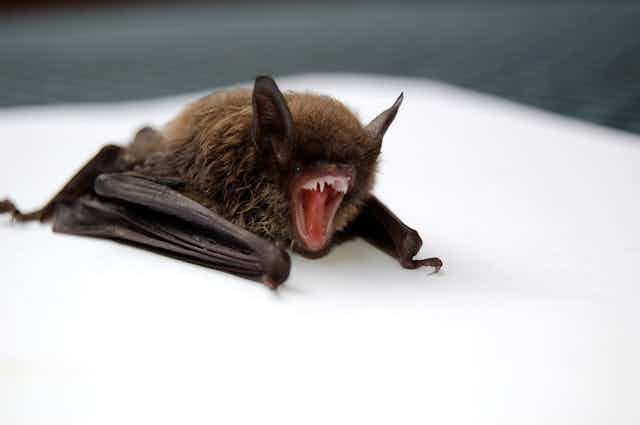There aren’t many better examples of two species embroiled in an intense struggle for survival than bats and moths. These two animals are the archetype of an evolutionary arms race, with each trying to one-up the other in the battle of survival between predator and prey.
Bats first evolved the ability to echolocate around 65 million years ago. By producing high frequency “clicks” with their mouth or nose and listening for echoes bouncing off objects, bats are able to illuminate the world around them with sound.
Echolocation allows bats to exploit hunting opportunities unavailable to other aerial predators. By hunting at night, they have the opportunity to pursue and consume nocturnal insects.
This ability has put huge pressure on the insects that bats target, such as crickets, lacewings and grasshoppers. That means many of these insects have evolved an extraordinary range of counter-adaptations to help them survive. And in no species are these so evident as in moths.
Many moths have evolved ears that are sensitive to bat echolocation calls. This allows them to hear bats approaching and take evasive action, like hiding in foliage or flying away.
Some moths have even evolved to produce sounds of their own, alerting bats that they are toxic. If a species emits high frequency clicks that are audible to an attacking bat, the bat will quickly learn to associate a clicking moth with a bad taste: and will stop targeting them altogether.
The clicks of some moth species are even able to “jam” bats’ echolocation calls. By timing their clicks to overlap with the clicks of an approaching bat, moths are able to confuse the bat, making it harder for it to reach its target.
Absorbing sound
At the University of Bristol, my colleagues and I are most interested in the defences of moths that don’t have ears. If they can’t hear an approaching bat, how might they increase their chances of survival? Moths without ears would have to have evolved passive defences, meaning adaptations that are present all the time, regardless of whether a moth is under threat from a nearby bat or not.
Recently, we’ve uncovered two such adaptations in moth species without ears. The first is acoustic camouflage. This is the sound equivalent of visual camouflage: when an octopus blends perfectly into a rock, or an insect looks exactly like a leaf.

To achieve this, earless moths have evolved specialised scales on their wings and body that absorb sound energy from an echolocating bat, causing the bat to receive a diminished echo from the moth’s body. By dampening the sound in this way, the moth is able to literally disappear from an echolocating bat’s “view” of the night sky.
The way that these scales are able to absorb sound is quite spectacular. Each scale on a moth wing vibrates in response to sound waves, but the scales all vibrate at slightly different frequencies. So working together, the scales are able to absorb sound at all the frequencies bats use for hunting, which span from 11 kilohertz to 212 kilohertz.
By vibrating, the scales dissipate sound energy by converting it to kinetic energy and heat. The lessons we’ve learned from these scales will hopefully help us create thinner sound-absorbing materials to line walls of buildings like music studios and buildings on busy residential roads, making the world a quieter place for all.
Diverting attacks
Another adaptation we’ve identified in moths is an acoustic decoy. This can be thought of as the sound equivalent to eyespots seen in fish and butterflies. The idea is to divert a predator’s attack away from the vital body parts of an animal, such as their head, towards more expendable appendages like fins and wings that could be lost without fatal damage.
In moths, these decoys take the form of elongated, twisted structures on the wingtips. Some moths also have long hindwings that end in a similar shape, known as streamer decoys.

The unique, undulating shape of these structures means that these body parts are excellent at reflecting sound, as well as scattering it over many different angles. Our research has shown that bats will attack these streamers rather than the vulnerable body of the moth itself. This makes it more likely for moths to survive bat attacks and live another day.
As we uncover new and fascinating tricks like these, it’s likely that we’re only just beginning to understand all the adaptations that these species have evolved. There is already some evidence that bats have changed their echolocation calls to sneak up on insects that have ears, whilst it remains to be seen if they can overcome other forms of defence such as acoustic camouflage. It seems moths currently have the upper hand in this arms race, but bats probably have a few tricks up their wings to fight them.

